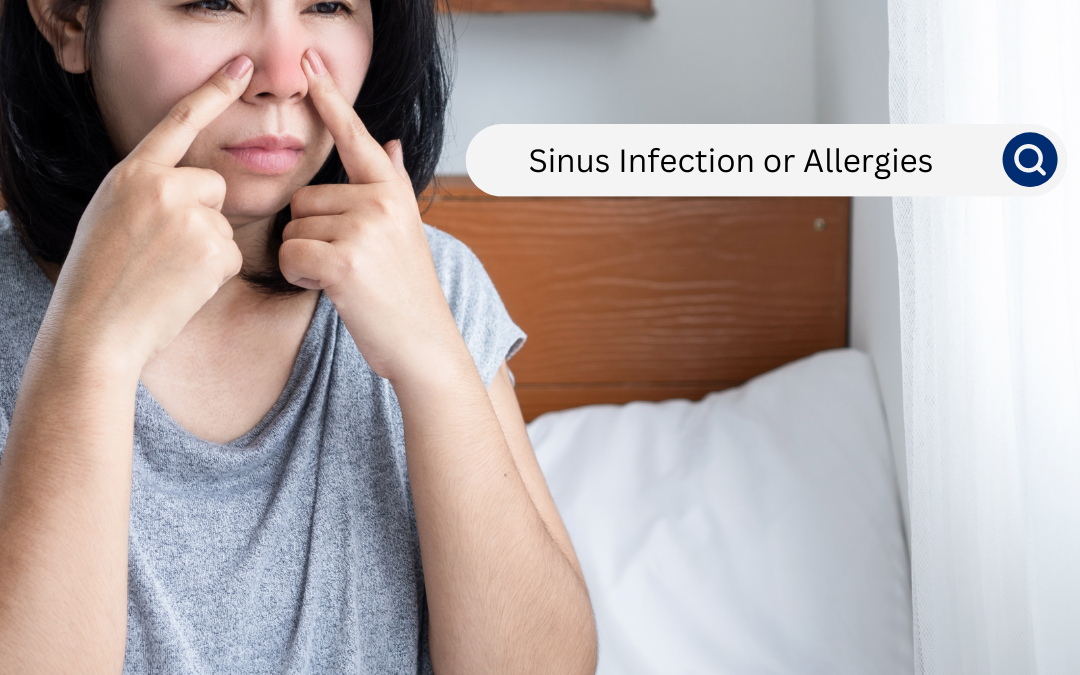At Premier, Asthma, and Sinus Care, we often encounter patients who struggle to differentiate between sinus infections and allergies. Both conditions can cause similar symptoms, leading to confusion and frustration. However, understanding the distinctions between the two is crucial for effective treatment and management. In this blog, we’ll delve into the nuances of sinus infections and allergies, shedding light on their causes, symptoms, and treatment approaches.
Sinus Infection:
A sinus infection, medically known as sinusitis, occurs when the sinuses become inflamed and swollen due to a viral, bacterial, or fungal infection. The sinuses are air-filled cavities located behind the forehead, cheeks, and eyes. When they become blocked and filled with fluid, it creates a conducive environment for the growth of bacteria or viruses, leading to infection.
Symptoms of Sinus Infection:
- Facial pain or pressure, particularly around the eyes, forehead, and cheeks.
- Nasal congestion and discharge, which may be thick and discolored.
- Coughing, often worsening at night.
- Reduced sense of smell and taste.
- Fatigue and general malaise.
Causes of Sinus Infection:
- Viral infections, such as the common cold or flu.
- Bacterial infections, typically following a viral infection or due to blockage of the sinus passages.
- Fungal infections, although less common, can occur, especially in individuals with weakened immune systems or underlying conditions.
- Chronic or recurrent sinus infections are often due to allergies.
Treatment of Sinus Infection:
Symptomatic Relief: Over-the-counter pain relievers, decongestants, and saline nasal sprays can help alleviate symptoms such as pain, congestion, and nasal discharge.
Antibiotics: If the sinus infection is bacterial in nature, antibiotics may be prescribed to target the underlying infection. Commonly prescribed antibiotics include amoxicillin, amoxicillin-clavulanate, or doxycycline.
Nasal Irrigation: Using a saline solution or nasal saline rinse can help flush out mucus and allergens from the nasal passages, promoting drainage and relieving congestion.
Corticosteroids: Nasal corticosteroid sprays may be recommended to reduce inflammation in the nasal passages and improve symptoms such as congestion and nasal discharge.
Sinus Surgery: In severe cases or when other treatments fail to provide relief, sinus surgery may be considered to remove nasal polyps, correct structural abnormalities, or improve sinus drainage. We recommend reaching out to your allergy provider for cases that aren’t seeing relief with over-the-counter treatments.
Allergen Immunotherapy (“allergy shots”) for chronic/recurrent sinusitis.
Allergies:
Allergies, on the other hand, are immune system responses triggered by exposure to allergens, substances that the body perceives as harmful but are typically harmless to most people. When an allergic individual comes into contact with an allergen, their immune system overreacts, releasing histamines and other chemicals that cause allergy symptoms.
Diagnosing Allergies:
Diagnosing allergies is a multifaceted process that involves careful assessment of symptoms, medical history, and often specific diagnostic tests. Here’s a breakdown of the steps typically involved in diagnosing allergies:
Medical History: The first step in diagnosing allergies is to take a thorough medical history. Your healthcare provider will ask about your symptoms, their duration and severity, any known triggers or patterns, and your personal or family history of allergies or other related conditions.
Physical Examination: A physical examination may be conducted to assess for signs of allergic conditions such as eczema, hives, or nasal congestion. Your allergy provider may also examine your nose, throat, and lungs for any abnormalities.
Allergy Testing: Allergy testing may be performed to identify specific allergens that trigger your symptoms. There are several types of allergy tests available, including:
Skin Prick Test (applying small amounts of allergens to the skin then pricking or scratching the skin to allow the allergen to enter)
Intradermal Test (injecting a small amount of the allergen into the skin using a needle)
Blood Tests
Patch Test
A consultation with an Allergist to put diagnosis and treatment together in a practical way.
Symptoms of Allergies:
- Sneezing, often in rapid succession.
- Runny or congested nose, typically clear discharge.
- Itchy or watery eyes.
- Coughing and wheezing, especially in individuals with allergic asthma.
- Skin reactions such as hives or eczema.
Common Allergens:
- Pollen from trees, grasses, and weeds.
- Dust mites found in bedding, upholstery, and carpets.
- Pet dander from cats, dogs, and other furry animals.
- Mold spores, particularly in damp and humid environments.
- Certain foods, such as peanuts, shellfish, or dairy products, can also trigger allergic reactions in susceptible individuals.
Treatment of Allergies:
- Avoidance of allergens whenever possible.
- Over-the-counter antihistamines to alleviate symptoms.
- Nasal corticosteroid sprays to reduce inflammation in the nasal passages.
- Allergy shots (immunotherapy) for long-term desensitization to specific allergens.
- Prescription medications, including leukotriene inhibitors or mast cell stabilizers, for more severe cases.
Distinguishing Between Sinus Infection and Allergies:
While sinus infections and allergies can share similar symptoms, there are some key differences that can help differentiate between the two:
Duration: Sinus infections often last longer than allergies. Allergy symptoms may come and go depending on exposure to allergens, while sinus infections typically persist for more than a week, especially if caused by bacteria.
Discharge Color: The color of nasal discharge can provide clues. Sinus infections often produce thick, discolored mucus, whereas allergies typically result in clear nasal discharge.
Fever: Fever is common with sinus infections, particularly those caused by bacteria. Allergies typically do not cause fever unless there is an associated infection.
Seasonal Patterns: Allergy symptoms may follow a seasonal pattern, correlating with the presence of specific allergens such as pollen. Sinus infections can occur at any time of year and are more likely to follow a cold or respiratory illness.
At Premier Allergy, Asthma, & Sinus Care, our goal is to help patients understand the underlying causes of their symptoms and provide personalized treatment plans tailored to their needs. While sinus infections and allergies can present similar symptoms, distinguishing between the two is essential for effective management. By identifying the root cause of symptoms and implementing appropriate treatment strategies, we can alleviate discomfort and improve the quality of life for individuals affected by these conditions.
If you’re experiencing persistent or severe sinus symptoms or allergy symptoms, don’t hesitate to consult with an allergy provider for personalized evaluation and treatment recommendations.





